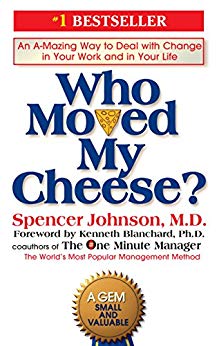

This article is an excerpt from the Shortform summary of "Who Moved My Cheese" by Spencer Johnson. Shortform has the world's best summaries of books you should be reading.
Like this article? Sign up for a free trial here .
Change is part of life. It can be distressing or rewarding, depending on our approach. Who Moved My Cheese is a parable that demonstrates in practical terms how to handle change better and avoid pitfalls, by practicing a few key principles: anticipate and prepare for change, overcome fears, envision success, and enjoy change.
Because change is part of life, we need to learn to deal with it. By depicting simple, memorable characters and scenarios, the parable gives you a framework for responding to change successfully.
The Narrative: Change Is Part of Life
Who Moved My Cheese teaches us that change is part of life. The story takes place in a maze, where four characters search for and consume cheese. Cheese represents happiness or satisfaction in its various forms — for instance, security, prestige, or wealth.
Two characters, Sniff and Scurry, are mice who take an industrious, uncomplicated trial-and-error approach to finding cheese. They don’t overthink things, instead trying out various routes until one day they find a large store of cheese.
The other two characters, Hem and Haw, are little humans who apply more sophisticated thinking and analytical skills to the daily search. They, too, find the same large stockpile of cheese as the mice.
But the two have very different attitudes toward their situation. The humans Hem and Haw take the cheese for granted, assuming it will always be there. By contrast, the mice stay alert to their surroundings. They notice that the quality and supply of the cheese are slowly dwindling.
One day the cheese is gone. How the characters cope with this change offers lessons in surviving and thriving despite the inevitable changes in life and the workplace.
The simple-minded mice don’t overthink things. They quickly accept the changed situation for what it is, not cursing the world or the environment for its unfairness. They know that change is part of life. They adapt to the change and immediately head out to look for new cheese. And while it takes concerted effort, they eventually find happiness in the form of a huge new pile of cheese.
In contrast, the humans Hem and Haw are shocked to lose the cheese. They had felt entitled to it, and they curse the world for its unfairness. They sit around, waiting for the cheese to reappear, and they become increasingly frustrated when it doesn’t. Hem yells, “Who moved my cheese?” He can’t wrap his head around the fact that change is part of life.
Eventually, hunger gnawing at him, Haw realizes his situation isn’t going to improve unless he changes his attitude and behavior. Going back out to the maze to find new cheese is scary, and it’ll take hard work. But he envisions the joy of finding cheese again, and it pushes him outward. He leaves behind Hem, who refuses to move and continues fuming at the unfairness of his situation.
In his journey, Haw overcomes his psychological barriers to adapting to change. He realizes that his fear of going back out to find new cheese was overblown — he had let the fear build up in his mind, and in reality it wasn’t that bad. He encounters setbacks in the maze, but he realizes he’s still happier taking control rather than being a victim of his situation. He continues imagining enjoying new cheese, which motivates him to push further. As he learns each of these lessons, he writes messages on the wall for Hem to read, should he ever decide to search for new cheese himself.
Finally, he finds a new giant pile of cheese, even bigger than the first. Sniff and Scurry have already been there for some time, happily enjoying the cheese. Haw reflects on how far he has come since the first cheese pile ran out, and he resolves to treat future change differently. He knows he’ll encounter change again–change is part of life.
If Change Is Part of Life, How Do You Deal with It?
Change is part of life, but it can be addressed successfully.
Be prepared for change: Because change is part of life, you know it’s coming. Pay attention to signs of change in your environment, whether it’s layoffs at your workplace, new aches and pains, or strains in your home life. Consider how potential changes could affect you and develop a plan to handle them – for instance, by learning new skills.
- In the story: Mice Sniff and Scurry noticed the cheese stockpile getting old and dwindling. They were ready (they kept their running shoes handy) to search for a new supply when the old one disappeared.
Let go of the past: When things change, move forward quickly. The longer you wait, the more resistance you build to moving, and the harder it’ll be to adapt later.
- In the story: Sniff and Scurry were action-oriented, and set off immediately to search for new cheese. It helped that they also kept things simple and didn’t overanalyze or overcomplicate things by, for instance, getting hung up on “what if’s.”
- In the story: Initially, Haw also stayed with Hem and wished for things to return to normal. But Haw came to his senses and realized the world had changed, and he had to change with it. Later he concluded that adapting to change is easier the less you wait. Change is part of life–don’t wait to adapt.
- Many people who finally muster the courage to leave a job or relationship that’s not working for them, often wonder in retrospect why they hadn’t made the change sooner.
Adapt—Be open-minded to new things: There are always experiences and opportunities available beyond those you are currently familiar with. You might like them even more than what you used to have.
- In the story: Haw found bits of new kinds of cheese (eg brie instead of the cheddar he was used to), and he tried them and liked them. This gave him confidence to keep pushing forward to even better experiences. (He tried sharing the new types of cheese with Hem but Hem rejected them, saying he wanted only the types he was familiar with.)
Imagine success: Envisioning what success looks like, and imagining yourself succeeding, can improve your attitude. When you think about what you will gain, rather than what you are losing, you realize change is part of life and change can be for the better.
- In the story: Haw at first imagined Sniff and Scurry enjoying new cheese, then he imagined himself, in realistic detail, sitting in his own pile of all kinds of new cheeses. This vision motivated him to keep pushing forward to find new cheese.
- When you imagine success, paint a picture in your mind of vivid detail. Think about how you’d behave in this new successful world. Imagine how you feel and how other people feel.
Handle your fears: Fear can have one of two effects: 1) It can paralyze you, if you imagine all that can go wrong if you leave your familiar ground, or 2) it can spur you into action if you fear that things will get worse if you don’t do something. The second fear is productive and healthy.
- In the story: Haw feared not finding new cheese if he ventured out into new areas of the maze. But he also realized he definitely wouldn’t find any by staying put. He asked himself, “What would you do if you weren’t afraid?”
Learn to enjoy change: Since change is part of life, you might as well enjoy it. New experiences, discoveries, and achievements are rewarding, usually more so than continuing to do the same things.
- In the story: Once Haw started searching for new cheese, he realized he felt better just from taking action, and he soon began to enjoy the adventure — he hadn’t realized how complacent he’d gotten from sitting around at the old cheese pile. The key to enjoying change was that he had changed — first his attitude, and then his behavior.
Be prepared for continuous change: Change is part of life. Change should only be a surprise if you aren’t paying attention, or if you’re operating on erroneous assumptions — for instance, that you’re entitled to having things a certain way.
- In the story: After finding the new cheese at the end of the book, Sniff and Scurry expected and prepared for even more change by continuing to explore new parts of the maze. Haw did the same thing, because he had learned from his mistakes and pledged not to be surprised by change again.
Remember that change is part of life–the better you can adapt to change, the better off you’ll be.
———End of Preview———

Like what you just read? Read the rest of the world's best summary of "Who Moved My Cheese" at Shortform . Learn the book's critical concepts in 20 minutes or less .
Here's what you'll find in our full Who Moved My Cheese summary :
- The absolute worst thing to do when change is coming
- How to adapt to change, like the key characters
- How to handle change in work and life






